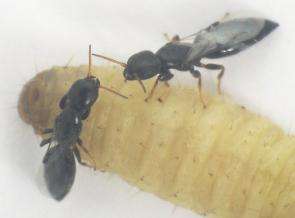Chemical exchanges show wasps are bad losers

Wasps have more than just a sting in their tail according to new research published this week in the Proceedings of the Royal Society B, they also carry the insect version of pepper spray in their heads, which they can release when fighting other wasps. The research not only gives us a fascinating insight into insect behaviour but could also help us to use wasps to kill crop destroying pests.
For the first time scientists, funded by the Biotechnology and Biological Sciences Research Council (BBSRC), have recorded 'chemical exchanges' undetectable by the human nose which take place between females of a species of bethylid wasp - Goniozus legneri, when they fight over larvae on which they lay their eggs. Not only have they discovered that chemical exchanges take place, but also that it is always the losing wasp that releases the potent gas.
While the research was primarily aimed at improving the understanding of animal behaviour, lead researcher Dr Ian Hardy, from the University of Nottingham, explains that there is great potential for applied spin-offs: "Bethylid wasps kill the larvae of many insects that are pests of crops, such as almonds, coffee and coconut, ruining harvests and costing industry thousands of pounds. These wasps could be used as a cheap and effective biological control to kill the larvae, avoiding the use of expensive and polluting pesticides. But for successful biological control, we need a good knowledge of wasp behaviour, including how wasps from the same and different species interact. Understanding these patterns can inform us of the best combinations of species to release against a given crop pest."
The scientists staged 47 separate contests between pairs of female wasps, placing them in a transparent chamber with a larva, which in the wild they paralyse to use as a host to lay their eggs on. One 'owner' female had paralysed the host 24 hours before the other wasp was allowed to intrude.
Making new use of a real-time chemical analysis technique known as Atmospheric Pressure Chemical Ionisation Mass Spectrometry (APCI-MS), as well as recording wasp behaviour on video, the researchers were able to study the visible and chemical behaviour of the wasps in tandem.
Behaviours displayed by the wasps included chasing, biting, stinging and full-on fighting. The video and chemical analysis showed that a volatile chemical, which is a type of spiroacetal, was released by the wasps when losing a particularly aggressive fight.
Dr Hardy said: "Our research suggests that wasps which have lost a fight release spiroacetal to temporarily and partially incapacitate the winner, it could be likened to the insect version of pepper spray. The volatile chemicals released by the wasps may prompt females to disperse away from the target area. If we understand how to reduce chemical release behaviour we can improve the efficacy of these wasps in pest control".
Professor Julia Goodfellow, BBSRC Chief Executive, said: "This research highlights the benefits of understanding animal behaviour and the impact this can have on finding solutions to tackle costly problems such as pest control."
Source: Biotechnology and Biological Sciences Research Council

















